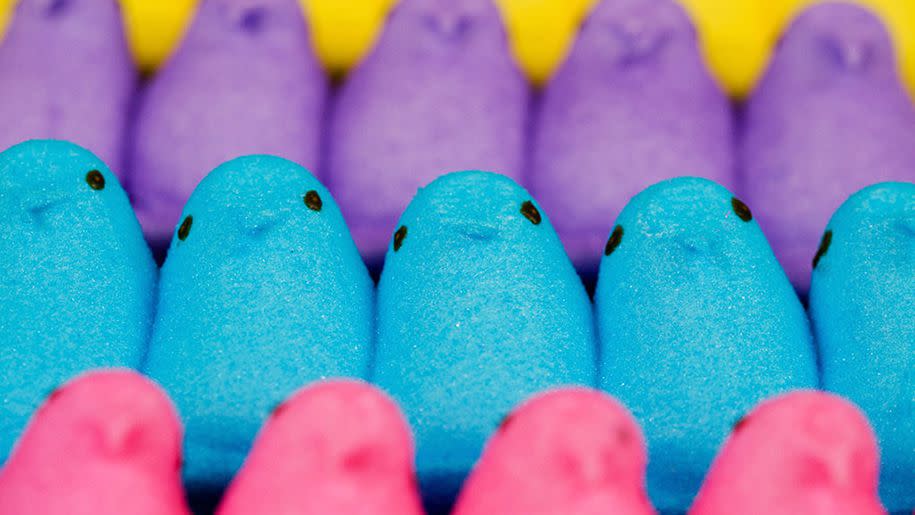The History of Peeps

© Amber Norris Photography / Getty Images
The first thing I do when I eat a Peep is bite its head off. Sure, it's rather morbid, but apparently I'm not the only one. According to a 2013 customer survey, nearly two thirds of Peep lovers do the exact same thing and decapitate the poor bird-shaped marshmallow.
For nearly seven decades, Peeps have been showing up in Easter baskets and blowing up in microwaves across the globe. However, the history of Easter's (surprisingly) only fifth most popular candy is actually quite complicated.
In 1910, 19-year-old Russian Jewish immigrant Sam Born landed in New York ready for a new life in America. Escaping the rising tide of anti-semitism and grumblings of revolution that would eventually come to pass seven years later, Born quickly got work in the US doing what he and his family did in Europe, which was making chocolate. In only a very few years, he was known as an innovator in his field. In 1916, according to the Candy Hall of Fame, he invented a stick-inserting machine for lollipops that was such a hit that it earned him the key to San Francisco. He called it the Born sucker machine. Company history also gives Born credit for creating a better way to make chocolate sprinkles and the solid chocolate coating that's used for Eskimo Pies. Born earned enough money to open his own chocolate retail store and factory in Brooklyn, where he displayed his freshest chocolate in the window with a sign that read "Just Born." To this day, the company's name remains just that. During the 1920s and '30s, Just Born grew rather significantly mostly due to the acquisition of other candy companies. Due to buying up of companies, they came into ownership of a giant factory in Bethlehem, Pennsylvania and moved Just Born there.
75 miles away from Bethlehem in Lancaster, Pennsylvania, the Rodda Candy Company—led by Roscoe E. Rodda—was going through growing pains. Constantly working in the shadow of Pennsylvania's other huge candy company, the company was embroiled in a multi-year legal battle over rights. Trying to find its place in an increasingly crowded market, Rodda Candy saw Easter as its way to profits. To this day, Lancaster remains the center of a historically German religious group known as "the Dutch" (derived not from the people of the Netherlands, but the German word for German "Deutsch"). Despite not being particularly religious themselves, Rodda appealed to them by producing candy shaped into religious icon imagery including bunnies, jelly eggs and Holy Crosses. This also included making treats out of Althaea officinalis, otherwise known as the "marshmallow plant," which is native Germany, France and the northeastern United States.
No one knows for sure when Rodda Candy made its first marshmallow chick, but a 1925 trade catalog (that's now in the collections of the Smithsonian's American History Museum) does not mention an item of that exact nature. There's speculation from the Rodda family that marshmallow chicks first made as a special-order item for loyal customers in the early 1940s, who enjoyed them as more of a decorative item than to actually eat. But it's unclear when the candy earned the "Peeps" moniker.
What is documented is that making these types of shaped marshmallows was an extremely labor-intensive process. It took perhaps as many as 80 people to make a limited amount only during the Easter season. Each worker spooned small batches of freshly-made marshmallow—made from the flower of the marshmallow plant, whipped egg whites and lots of sugar—into a fluted steel tip, which squirted out the mixture in the shape of baby chicks. Then, they were left to air-dry. Records say that it took upwards of 27 hours to make one tray of these first "Peeps."
With Roscoe Rodda's death in the late 1940s, Rodda Candy Company was looking to sell and Just Born was looking to buy. In 1953, Born's company did just that. By now, Bob Born (Sam's son) was in charge of the company and he was a big believer in automation. The next year, he built the "Depositor," an automated machine that spit out six rows of five Peeps at a time. Rather than taking 27 hours to make one tray of peeps, it now took six minutes. For six decades, the Depositor made perfect Peeps. But in 2014 it was finally replaced with a new state-of-art-machine. With a hint of sadness, co-CEO Ross Born (Sam's grandson) said at the time to Candy Industry Magazine, "The [old] Peeps line did one thing and one thing very well—cranking out chicks day in and day out...(but the new machine) saves a lot of space."
Today, Peeps inspires a cult following. There are creative dioramas, celebrity chef recipes and competitive eating contests. This year, in five minutes, the winner Matt Stonie ate 255 Peeps—most of which head first.

